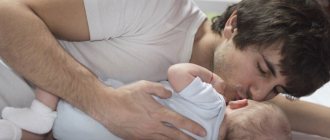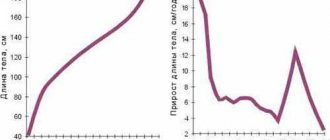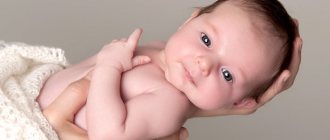Newborn pose
A newborn baby is characterized by the so-called fetal position, or flexion position. The fact is that by the end of pregnancy the baby becomes cramped in the uterus, the arms and legs are forced to be constantly tucked in. As a result, a physiological increase in the tone of the flexor muscles appears, which persists for some time after birth. The baby's arms are bent at the elbow joints and pressed to the side surface of the chest, the hands are clenched into fists, the legs are bent at the knee and hip joints, and the head is brought to the chest. When attempting to straighten the limbs, they return to their original position. Muscle tone - that is, their resistance - can be increased, decreased or different in different muscle groups and different halves of the body (so-called dystonia). Sometimes, on a flat horizontal surface, newborns take the “fencing” pose: the head is turned towards the shoulder, the arm and leg are bent on one side, and on the other side they are in an extension position. The “fencing” pose is more common in older children.
Determining the size of a newborn baby
To determine the rate of development of a newborn baby, a special table of the optimal sizes of infants has been developed. Of course, every child will not meet the general indicators, but a significant deviation from the norm may indicate developmental disorders of the body, and timely help will help correct possible anomalies.
How tall should a newborn be?
The main indicators of a child’s development in infancy are weight and height. The body length of an infant directly depends on several factors: hereditary predisposition, quality and quantity of nutrition, diseases and the environment.
Each visit to the pediatrician is accompanied by a height measurement; for this, nurses use a special electronic device that allows data to be obtained with millimeter accuracy. However, this procedure can be carried out at home on your own. The best option is to place the child on a flat surface and stretch a sewing ruler nearby. The first procedures may require the assistance of a second adult to hold the spinning infant. The baby should lie flat, legs straight, at full height - from the top of the head to the heels.
The increase in body length of a newborn is carried out gradually, but the peak occurs in the first quarter of the year - at this time the baby adds 3 cm. The next three months the increase is less intense - from 2 to 2.5 cm monthly. From 6 to 9 months, the baby will lengthen by 1.5-2 cm for each month, and in the last quarter of the first year of life, growth will increase by about 1 cm. For convenience, there is a table of the average height of infants by month:
- at birth – 45-55 cm;
- from birth to 3 months. – 45-62 cm;
- from 3 to 6 months. – 51-68 cm;
- from 6 to 9 months. – 57-74 cm;
- from 9 to 12 months – 63-80 cm;
- from 12 to 18 months. – 70-86 cm.
Of course, these are general size indicators, and they should not be taken as the final norm, because each child develops individually, but a long-term deviation from the results of the table should alert parents, because this is one of the possible factors for impaired development of the infant.
Measuring the body size of the baby
Every month, during a routine examination with a doctor, along with weighing, infants undergo a procedure for measuring body size. The main indicators of interest to specialists are height, head and chest circumference.
Immediately after birth, the baby’s body will be disproportionate - the head stands out especially, and its figure is slightly higher than the chest circumference. By six months, the circumferences of the head and chest become approximately the same, and after 6 months the child’s chest begins to expand, and the body proportions return to normal.
Head circumference is measured horizontally, covering the back of the head, ears and forehead. You can check it yourself using a soft measuring tape.
Head circumference size chart:
- at birth – 34-35 cm;
- from birth to 3 months. – 34-40 cm;
- from 3 to 6 months. – 40-44 cm;
- from 6 to 9 months. – 44-46 cm;
- from 9 to 12 months – 46-48 cm;
- from 12 to 18 months. – 48-50 cm.
This indicator allows you to choose the right hats and bonnets for a newborn, so before buying new things it is recommended to measure your head; it won’t take much time, but it will save you from the difficulties of choosing children’s hats.
The chest circumference also increases as the child grows; if in the initial months the increase is 1.5-2 cm per month, then after six months the figure will steadily change by only 0.5-1 cm.
Chest circumference chart for infants:
- at birth – 30-32 cm;
- from birth to 3 months. – 30-38;
- from 3 to 6 months. – 38-45 cm;
- from 6 to 9 months. – 44-50 cm;
- from 9 to 12 months – 50-52 cm;
- from 12 to 18 months. – 52-54 cm.
Knowing the chest circumference, you can easily choose the right size for your child, which will simplify the choice of models and save you a lot of time.
How to determine the sizes of clothes and shoes for a baby?
To purchase new clothes for a small child’s wardrobe, you should know exactly what size the baby is currently wearing, since it is better for a baby to buy things with a small supply, because children grow very quickly.
As for clothing, the best option would be to follow the proposed branded sizing chart, but this applies only to domestically produced goods. It is better to measure models from China and other foreign ones yourself. All you need to know is the baby’s height (to determine the required length of trousers) and chest circumference (to choose a blouse that is not too wide).
But it is better to measure shoes according to the length of the child’s foot, since different manufacturers use different sizing grids when making children’s slippers and booties. The length of the leg is measured from the heel to the tip of the big toe. Another option is to trace the leg on a piece of cardboard with a pencil and cut out a model that you can use to measure the models you like.
Approximate table of infant leg sizes:
- from birth to 3 months – 7-9 cm;
- from 3 to 6 months – 9-11 cm;
- from 6 to 9 months – 11-14 cm;
- from 9 to 12 months – 14-15 cm;
- from 12 to 18 months – 15-18 cm.
Even an approximate table of sizes will help you choose suitable things for a small child, since it is not always possible to determine by eye exactly what size a baby is at the moment.
agushkin.ru
Body proportions
Newborns are characterized by special ratios of body weight, height, chest circumference and head circumference. If these relationships are violated, they talk about disproportionate development and find out its reasons, which can be extremely diverse. The average height of a newborn is about 50 cm. A very large head makes up 1/4 of the height (for comparison: in an adult it is 1/7). The arms and legs are short and weak, with the arms being longer than the legs. The body is longer than the limbs. Boys' genitals appear disproportionately large.
All babies have a prominent and large belly. However, a greatly increased belly is evidence of increased gas formation. However, a “spread out” tummy, like a frog’s, is also not a very good sign that will worry the doctor.
Child growth rate by age
The rate of change in body length is greatest at the very beginning of a child’s life and gradually decreases as he grows older. This dependence manifests itself when considering the initial stages of development sequentially:
- Intrauterine. In 9 months, the body turns from one cell into a baby 49-54 cm tall and weighing 2.7-4 kg.
- First month of life. Gains 3 cm and 700-1000 g in weight.
- First year of life. By the end of this period, the baby grows to 73-76 cm and gains a weight of 10 kg.
Subsequently, the growth rate gradually decreases, and by the age of 16-18 this process stops altogether.
The rate of change in body length varies unevenly. The following stages of physical development occur in turn:
- traction;
- rounding.
The duration of each stage is 1.5-3 years. Of all the periods of rounding, the most pronounced one occurs at the age of 3-5 years, and a person stretches the most during adolescence.
Head shape
In children after natural childbirth, birth swelling and cephalohematoma may appear on the head. These hemorrhages are common and do not pose a threat to health. There are two fontanels on the head of a newborn - a large one on the crown and a small one on the back of the head. These are non-fusions of the skull bones, which by the age of one year are covered with cartilage tissue, and until then are covered with a flexible but dense membrane. Normally, the large fontanel may be slightly retracted, but in no case convex (this indicates increased intracranial pressure).
Sometimes in the first days of life, the bones of the skull overlap each other, the sutures can be clearly felt - these consequences of childbirth are quite normal. By the way, the condition of the sutures and fontanelles can tell the doctor a lot about how the birth proceeded.
Sense organs
- vision functions from birth, but is approximately 20 times worse than that of an adult. He clearly sees only objects located at a distance of 25 cm. The angle of vision is 30 degrees (that is, he sees only what is directly in front of him). Harsh light is unpleasant for the baby, so the baby spends most of the time with his eyes closed. A newborn is characterized by an unfocused gaze, the eyes may “float”, and sometimes nystagmus occurs—the rolling of the eyes. Convergent strabismus is often observed in children. All these are normal conditions for the first days of life and should go away in a month.
- Hearing is much better developed than vision, since it appears and improves over several months of gestation. The baby distinguishes noises, recognizes human speech and very quickly learns to recognize the voices of its parents.
- sense of touch is very subtle, “trained” by the entire intrauterine life. The baby is very sensitive to touch, especially affectionate touch.
- The sense of smell is one of the most important senses for a child: after all, it is thanks to it that he recognizes the mother’s breast, full of delicious milk.
- taste sensations in the last months of pregnancy. He doesn’t like bitter and sour things, nor does he like salty things, but he really likes sweet things.
Organ and tissue growth chart
The studies revealed patterns in changes not only in external signs - height and weight - but also in the size of internal organs. The relationship between them and the child’s body length is reflected in the table:
| Body length, cm | Right lobe | Left lobe | Pancreas | Spleen | bud | ||||
| head | body | tail | length | width | length | width | |||
| 35-49 | 36,0-51,4 | 26,7-42,5 | 6,2-9,8 | 4,3-7,1 | 5,6-8,0 | 34,9-47,5 | 18,1-26,5 | 36,1-45,7 | 17,8-23,0 |
| 49-59 | 48,3-58,9 | 21,9-36,5 | 6,0-9,0 | 4,1-5,9 | 7,3-9,5 | 40-46,2 | 19,9-29,5 | 46,2-54,4 | 22,1-27,7 |
| 60-69 | 53,0-66,0 | 26,4-40,8 | 6,4-9,0 | 4,5-6,7 | 8,1-10,7 | 47,8-61,4 | 22,6-29,8 | 50,5-58,3 | 24,5-29,7 |
| 70-79 | 62,6-73,8 | 32,7-48,1 | 8,7-11,7 | 5,9-8,9 | 10,4-14,0 | 56,3-67,9 | 24,5-32,3 | 55,5-63,7 | 26,8-32,2 |
| 80-89 | 67,5-78,9 | 40,2-55,6 | 8,7-12,9 | 6,4-9,2 | 10,5-15,3 | 62,1-72,1 | 27,7-34,7 | 61,8-72,2 | 29,1-33,7 |
| 90-99 | 73,9-85,3 | 47,4-63,8 | 10,4-14,8 | 7,4-10,0 | 11,6-17,0 | 63,8-78,0 | 30,4-38,0 | 63,9-74,1 | 30,6-36,8 |
| 100-109 | 79,6-92,6 | 45,5-65,9 | 12,6-15,8 | 8,2-11,0 | 13,0-17,8 | 65,9-80,3 | 32,6-40,0 | 68,5-76,7 | 31,3-37,9 |
| 110-119 | 75,3-97,5 | 57,0-73,0 | 13,2-17,2 | 7,9-10,7 | 15,4-19,8 | 70,8-83,0 | 33,8-41,6 | 71,9-81,7 | 32,9-39,3 |
| 120-129 | 88,4-102,2 | 61,1-79,1 | 15,1-18,7 | 8,7-11,9 | 16,4-21,0 | 76,6-91,4 | 36,7-44,5 | 76,8-86,5 | 34,3-40,7 |
| 130-139 | 87,8-104,8 | 67,2-81,8 | 14,1-18,3 | 8,7-11,5 | 15,7-19,9 | 79,6-98,2 | 36,1-47,7 | 81,2-90,0 | 35,8-43,0 |
| 140-149 | 97,2-112,6 | 61,0-83,8 | 14,6-19,0 | 8,7-12,1 | 15,8-20,8 | 83,0-101,4 | 39,5-50,5 | 85,3-94,7 | 37,3-45,5 |
| 150-159 | 101,8-125,6 | 66,7-87,1 | 15,0-19,4 | 9,5-12,5 | 15,9-21,1 | 88,5-107,7 | 41,3-51,7 | 86,6-102,2 | 38,3-46,9 |
| 160-169 | 105,3-127,7 | 64,9 -93,3 | 15,5-20,3 | 9,1-12,5 | 17,8-22,0 | 93,8-111,0 | 54,6-43,4 | 94,5-109,5 | 41,0-50,2 |
| 170 and above | 107,3-128,7 | 70,1-92,3 | 16,8-21,2 | 9,8-12,8 | 18,8-23,6 | 99,2-117,8 | 44,8-58,4 | 98,3-110,1 | 43,0-53,2 |
Oral cavity
The mouth of an infant is an excellent tool for sucking: a large tongue, folded mucous membranes, lips with plump “pads”. On the upper lip during feeding, you can distinguish a special “sucker” - it is this that helps him hold the nipple, and at the same time makes the baby’s lips so touchingly plump. Round cheeks are not given to a child for the sake of beauty: fatty lumps on the cheeks create a rarefied atmosphere in the oral cavity and also help sucking. If for some reason the baby loses catastrophic weight, the roundness of the cheeks will be the last thing to disappear - after all, without them the baby will not be able to feed on his own!
4–5% of newborns develop oral thrush. It occurs when there are defects in care and nutrition, as well as when the child’s body has reduced resistance to the yeast-like fungi Candida.
Stages of development
In the initial period of a person’s life up to 18 years of age, the following stages are distinguished:
- Infancy. In the second month of life, the child begins to hold his head up. During the first month, he is examined weekly by a visiting nurse. At 3 months the baby turns over on his stomach, begins to grab objects, and at 4 months he pulls himself up. A 5-month-old child briefly lingers in a sitting position, and a six-month-old child sits down, crawls, and stands on his feet, holding onto a support. From 1 month to a year, the child is brought to the pediatrician every month.
- From 6 months to 2 years. The child begins to walk, and by the end of this period he jumps, walks on his toes, and climbs stairs. During this time, it is important to monitor foot development and posture. Children from 1 to 3 years old are examined by a doctor quarterly.
- Third year of life. The child is able to stand on one leg, catches a ball thrown from a long distance and throws it just as far. Children over 3 years of age are examined by a doctor annually.
- Senior preschool age. The physical development of preschool children is monitored by a kindergarten health worker, especially during exercises. If deviations are detected, information about this is communicated to parents.
- Primary and secondary school age. The process of biological maturation is monitored by the pediatrician during annual examinations and by the physical education teacher. By the age of 12, the formation of the skeleton is completed, so correct posture becomes especially important. If the physical development of young children is predictable, then for the period of 9-14 years the norms of body length and weight are conditional.
- Senior school age. During this period, the ontogenesis of the organism is completed.
Hormonal changes are observed in the body of primary and secondary preschoolers, and it is impossible to predict at what point the level of substances will provoke intensive growth. Pediatricians take average indicators as guidelines, but if a child does not meet them, this does not indicate a violation. In addition, at this age, heredity already manifests itself: with short parents, the child is most likely to be short, and vice versa.
In Russia there is a Federal State Educational Standard (FSES). These are mandatory guidelines for schools and kindergartens regarding the biological maturation of children. For example, for preschoolers, the standard prescribes morning exercises, periodic physical exercises during classes, jogging, playing in the fresh air, etc.
The task of the Federal State Educational Standard as an “education technology” is to raise young people with high moral and volitional qualities, to develop in them the ability to be active and the habit of playing sports, hardening, and other health-improving procedures.










